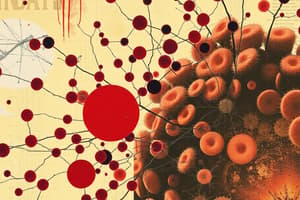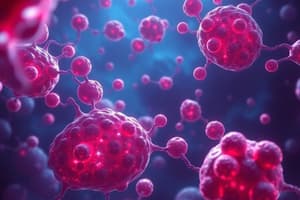Podcast
Questions and Answers
Which cell type represents the earliest stage of granulopoiesis?
Which cell type represents the earliest stage of granulopoiesis?
- Mature granulocyte
- Metamyelocyte
- Myeloblast (correct)
- Promyelocyte
What happens during the maturation of granulocytes?
What happens during the maturation of granulocytes?
- An increase in nucleus volume
- Decreased cell size
- Appearance of primary granules
- Condensation of chromatin (correct)
Which stage of granulopoiesis is characterized by the appearance of specific granules?
Which stage of granulopoiesis is characterized by the appearance of specific granules?
- Mature granulocyte
- Myeloblast
- Promyelocyte
- Myelocyte (correct)
What is the role of metamyelocytes and band cells in granulopoiesis?
What is the role of metamyelocytes and band cells in granulopoiesis?
What process describes the movement of granulocytes from the circulating pool to peripheral tissues?
What process describes the movement of granulocytes from the circulating pool to peripheral tissues?
Which granulocyte type is considered the most mature stage?
Which granulocyte type is considered the most mature stage?
What defines the two pools of peripheral blood circulation for granulocytes?
What defines the two pools of peripheral blood circulation for granulocytes?
Which of the following stages in granulopoiesis does NOT undergo mitosis?
Which of the following stages in granulopoiesis does NOT undergo mitosis?
What size range characterizes a myeloblast?
What size range characterizes a myeloblast?
Which feature distinguishes myelocytes from earlier stages in granulopoiesis?
Which feature distinguishes myelocytes from earlier stages in granulopoiesis?
In which stage of granulopoiesis does the nucleus first take on a kidney/horse-shoe shape?
In which stage of granulopoiesis does the nucleus first take on a kidney/horse-shoe shape?
What color are the primary granules observed in promyelocytes?
What color are the primary granules observed in promyelocytes?
Which of the following statements about Auer rods is accurate?
Which of the following statements about Auer rods is accurate?
What is the chromatin pattern in a myelocyte?
What is the chromatin pattern in a myelocyte?
In which cell type do eosinophilic granules first become recognizable?
In which cell type do eosinophilic granules first become recognizable?
What characteristic do segmented neutrophils possess in terms of nuclei?
What characteristic do segmented neutrophils possess in terms of nuclei?
What substances are predominantly found in the granules of segmented neutrophils?
What substances are predominantly found in the granules of segmented neutrophils?
Which type of granules do eosinophils lack compared to neutrophils?
Which type of granules do eosinophils lack compared to neutrophils?
What is the primary function of monocytes in the immune system?
What is the primary function of monocytes in the immune system?
Which growth factor is essential for the proliferation and growth of granulocytes?
Which growth factor is essential for the proliferation and growth of granulocytes?
What distinguishes a promonocyte from a monoblast?
What distinguishes a promonocyte from a monoblast?
Which cell type is primarily responsible for the production of monocyte precursors?
Which cell type is primarily responsible for the production of monocyte precursors?
What role do cytokines such as IL-1 and tumor necrosis factor play in granulopoiesis?
What role do cytokines such as IL-1 and tumor necrosis factor play in granulopoiesis?
Which component of basophilic granules is associated with inflammatory responses?
Which component of basophilic granules is associated with inflammatory responses?
Flashcards
Granulopoiesis
Granulopoiesis
The process of creating mature granulocytes (neutrophils, eosinophils, and basophils) in the bone marrow.
Granulocyte-Monocyte Colony Forming Unit (GM-CFU)
Granulocyte-Monocyte Colony Forming Unit (GM-CFU)
A type of stem cell in bone marrow that gives rise to granulocytes and monocytes.
Myelocyte Stage
Myelocyte Stage
The stage where granulocytes develop their specific granules, distinguishing them from other blood cell types.
Differentiation
Differentiation
Signup and view all the flashcards
Proliferation
Proliferation
Signup and view all the flashcards
Maturation Pool
Maturation Pool
Signup and view all the flashcards
Diapedesis
Diapedesis
Signup and view all the flashcards
Segmented Neutrophils
Segmented Neutrophils
Signup and view all the flashcards
Myeloblast
Myeloblast
Signup and view all the flashcards
Promyelocyte
Promyelocyte
Signup and view all the flashcards
Myelocyte
Myelocyte
Signup and view all the flashcards
Metamyelocyte
Metamyelocyte
Signup and view all the flashcards
Band Cell
Band Cell
Signup and view all the flashcards
What are granules?
What are granules?
Signup and view all the flashcards
Why do granules stain differently?
Why do granules stain differently?
Signup and view all the flashcards
Differentiation of Granulocytes
Differentiation of Granulocytes
Signup and view all the flashcards
Proliferation of Granulocytes
Proliferation of Granulocytes
Signup and view all the flashcards
Granulocyte Storage and Release
Granulocyte Storage and Release
Signup and view all the flashcards
Study Notes
Granulopoiesis Definition
- Granulopoiesis (or Myelopoiesis) is the process of proliferation, differentiation, and maturation of granulocytes within the bone marrow.
- Granulocytes develop from pluripotent hematopoietic stem cells.
- Pluripotent hematopoietic stem cells (PHSC) differentiate into granulocyte-monocyte colony-forming units (GM-CFU).
- GM-CFU then further differentiates into granulocyte colony-forming units (G-CFU).
- G-CFU undergo successive divisions and maturation stages to eventually create mature granulocytes.
Granulopoiesis Stages
- Granulopoiesis involves a continuous development process from myeloblast to mature granulocytes within the bone marrow.
- Each granulocyte type follows a similar developmental pathway (myeloblast, promyelocyte, myelocyte, metamyelocyte, band cell, mature granulocyte).
- Granulocytes become distinguishable at the myelocyte stage when specific granules appear.
- During maturation, the nucleus shrinks, chromatin condenses, and the shape of the nucleus changes significantly.
- Primary granules appear and disappear, while secondary granules emerge. The cell's size also changes.
- Myeloblasts, promyelocytes, and myelocytes undergo mitosis and have the capability to divide.
- Metamyelocytes and band cells are components of a maturation pool and do not divide.
- Segmented neutrophils are stored in the bone marrow and released into the circulation.
- The circulatory system divides into two parts: circulating and marginating pools.
- Marginating granulocytes adhere to the blood vessel endothelium.
- Some granulocytes are found in the spleen, while mature forms circulate in the blood and are transient to tissue.
- Granulocytes migrate from circulation into peripheral tissues via diapedesis.
Granulopoiesis Stages: Specific Cells
-
Granulopoiesis is subdivided into six stages: myeloblast, promyelocyte, myelocyte, metamyelocyte, band cells, and mature granulocytes (neutrophils, eosinophils, basophils).
-
Myeloblast: Large, round-to-oval cells, scanty basophilic cytoplasm, lacking granules. The myeloblast sometimes displays "Auer rods," which signifies a pathological and abnormal condition
-
Promyelocyte: Slightly larger than myeloblasts (15-21 µm), moderate basophilic cytoplasm, and primary granules within the cytoplasm
-
Myelocyte: Smaller than promyelocytes (12-18 µm), primary and some secondary granules, basophilic cytoplasm (fewer) and a darker staining nucleus with coarsely clumped chromatin
-
Metamyelocyte: Smaller than myelocytes, the nucleus is indented in a kidney or horseshoe shape. Pinkish cytoplasm
-
Band Cell: Nucleus is in a band shape, smaller than Metamyelocytes in size. Pinkish cytoplasm
-
Segmented Neutrophils (Mature Granulocytes): The nucleus has multiple segments, the cytoplasm is abundant and pink, containing granules that are pinkish-colored secondary granules.
Granulocyte Characteristics
- Granules of each granulocyte type differ in staining characteristics due to varying content.
- Segmented neutrophil granules have antibacterial substances, like lysosomal hydrolases, lysozyme, and myeloperoxidase.
- Eosinophil granules lack lysozyme, and basophil granules contain heparin and histamine.
Granulopoiesis Regulation
- Growth factors are crucial in the proliferation, growth, and maturation of granulocytes.
- These factors include GM-CSF, G-CSF, IL-6, IL-11, IL-1, IL-3, and IL-5.
- Increased granulocyte and monocyte production is triggered when infection occurs.
- Stromal cells and T lymphocytes increase the production of growth factors in response to endotoxins and cytokines, such as IL-1 or tumor necrosis factor (TNF).
Monocyte Development
- Monoblasts are precursors to monocytes, which mature into macrophages.
- Monoblasts are large cells with a round nucleus, fine chromatin, and a prominent nucleolus. Cytoplasm can be agranular or have fine basophilic granules.
- Promonocytes are immature cells developing from monoblasts into monocytes.
- Promonocytes have a moderate amount of blue–gray cytoplasm, fine granules, and sometimes cytoplasmic vacuoles. Their nuclei are irregular, folded, and convoluted, with less condensed chromatin compared to mature monocytes.
Monocyte Function
- Monocytes are part of the immune system that defend against pathogens.
- Monocytes are produced in bone marrow and enter the bloodstream.
- They travel to various tissues (spleen, liver, lungs, bone marrow).
- They act as scavenger cells by ingesting bacteria and other substances, as well as eliminating infected cells.
- They play a role in tissue repair and influence adaptive immune responses.
- Monocytes have a large, kidney-shaped nucleus, pale greyish-blue cytoplasm, and reddish-blue granules.
Clinical Application of G-CSF
- G-CSF (granulocyte colony-stimulating factor) is a therapeutic agent used intravenously or subcutaneously to increase neutrophil counts.
- It's used after chemotherapy/radiotherapy, stem cell transplantation, myelodysplasia, aplastic anemia, and severe benign neutropenia.
- Short-acting G-CSF is given daily, while longer-acting types are given every 7-14 days.
Studying That Suits You
Use AI to generate personalized quizzes and flashcards to suit your learning preferences.




